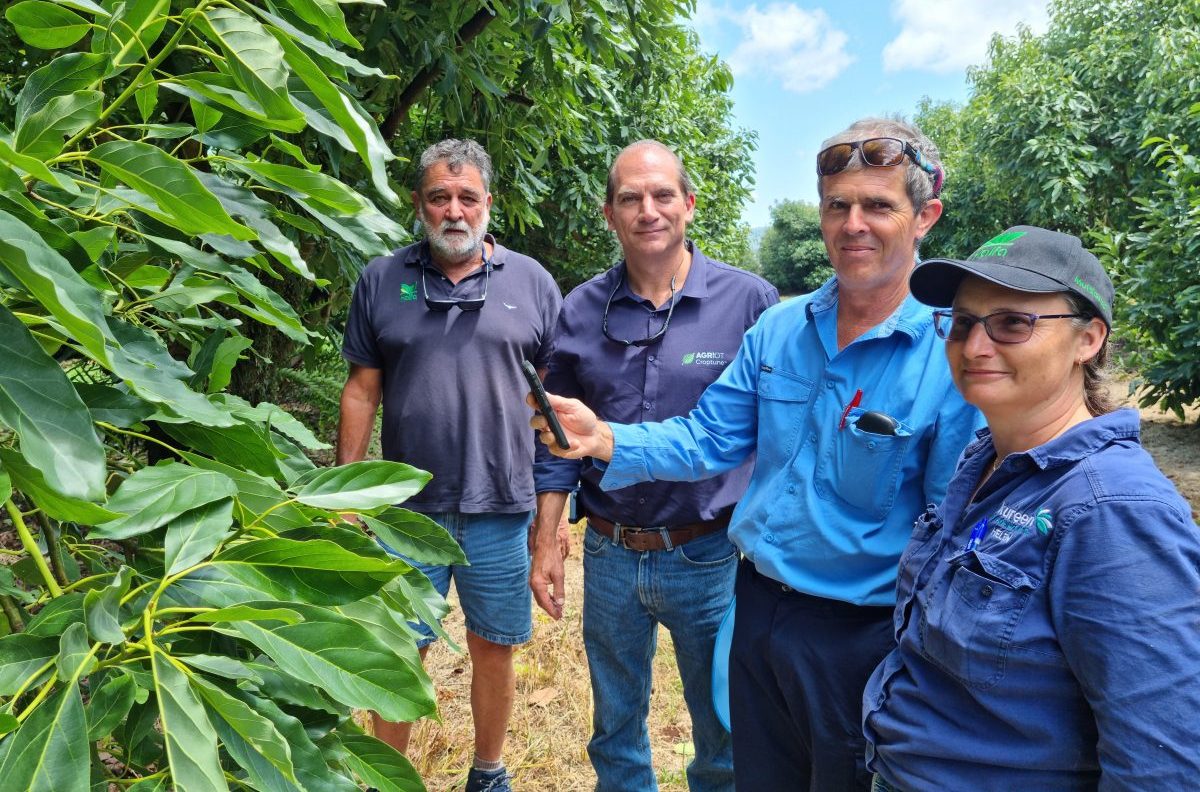
Haifa Australia northern sales agronomist Peter Anderson, Croptune product and agronomy manager Eldad Sokolowski, Lindsay Rural Mareeba’s Aaron Myrteza and Avomac farm manager Helen Bensilum put Croptune to work in a Kureen Farming avocado plantation at Kairi near Tolga in North Queensland. Photo: Haifa Australia
GROWERS can gain the nitrogen (N) nutrition status of a range of crops instantly following the launch of a smartphone app that aims to assist the most efficient application of fertilisers in order to maximise returns and protect the environment.
Croptune uses smartphone cameras to take leaf photos, upon which it measures chlorophyll and provides both a plant N uptake and percentage-range reading for annual crops, as well as a percentage range measurement for perennial crops.
In perennial crops, the percentage measurement allows growers to track the N nutrition status in real-time and, if necessary, adjust applications immediately, rather than be delayed waiting for laboratory plant analysis results.
So far, the Croptune app has been calibrated for 18 crops, including wheat, cotton, corn, and rice, as well as 14 horticultural crops, with sugarcane expected to be added next year.
Croptune product and agronomy manager Eldad Sokolowski travelled to Australia from Israel to launch the app with Haifa Group, which partnered in its development.
Mr Sokolowski said calibration required a full season and hundreds of samples for each crop.
It aligns laboratory N analysis with leaf greenness levels, and continually improves through the use of artificial intelligence.
Mr Sokolowski said currently there were about 40 greenness layers used for nitrogen measurement of each crop, with the aim to achieve more than 100 layers to further improve its accuracy.
“Currently the accuracy is 85-90 per cent with the laboratory results, which also are not perfectly accurate,” Mr Sokolowski said.
“We estimate labs have 90pc accuracy and indicate a single figure rather than a range, so the correlation is very close.’’
Growers also can target specific areas within whole paddocks or blocks with the app to help further fine-tune their nutrition management and, together with their agronomist or adviser, they can access a developing databank of the areas.
In future, it can contribute to aerial N maps for paddocks or blocks.
Eldad said for the N application recommendation, growers entered several details into the app including the planting date and plant density.
“From the age of the crop and the plants per area, the app knows what the N level should be at that time.’’
Nitrogen inputs reduced
He said one of the key aims was to allow growers to apply the minimum base fertiliser required upfront, and then to use the app to understand the crop-nutrition status and make applications accordingly.
Use of the app in crop trials has shown a reduction in fertiliser application in wheat of 35 kilograms per hectare for 46pc higher nutrient-use efficiency, with lower fertiliser applications also reducing carbon dioxide emissions.
Mr Sokolowski said the app was developed initially for the widest-grown crops in the world and the most popular varieties, but the list of crops would continue to grow, and work was ongoing to add further varieties.
It also will undergo accreditation for use to meet environmental regulations in Israel and this could pave the way for similar developments in Australia.
Haifa Australia managing director Trevor Dennis said as part of the company’s commitment to the 17 Sustainable Development Goals (SDGs) under the United Nations Global Compact initiative, the adoption of systems for sustainable agriculture was a key focus.
Mr Dennis said the primary target with the app was to improve the efficient utilisation of fertilisers for growers and also the broader community and environment.
The Croptune app is suitable for use with a range of iPhone, android and Google handsets, and the use default camera settings is advised.
In areas with poor connectivity, the app can store the images for analysis later.
The Croptune app is available to growers and advisers via app stores, where users can annually subscribe to field or orchard crop versions for around $20 per month.
A free trial of the app is available, and availability through rural resellers is being explored to make it as cost-effective as possible for users.
Source: Croptune

HAVE YOUR SAY